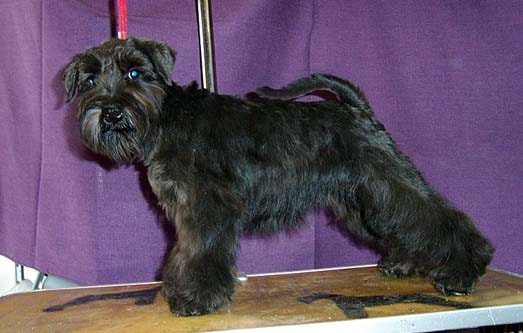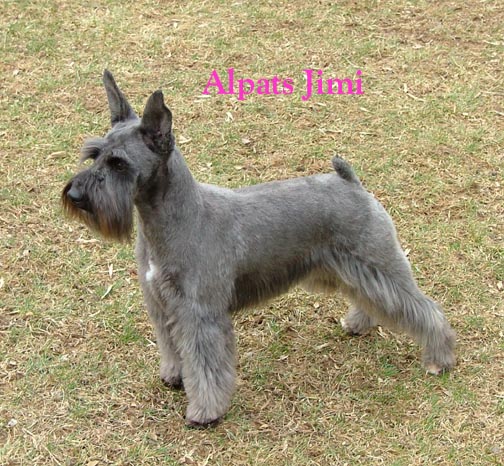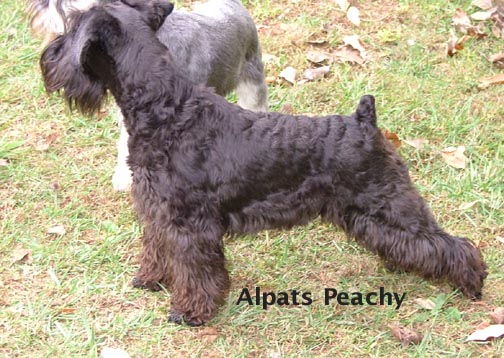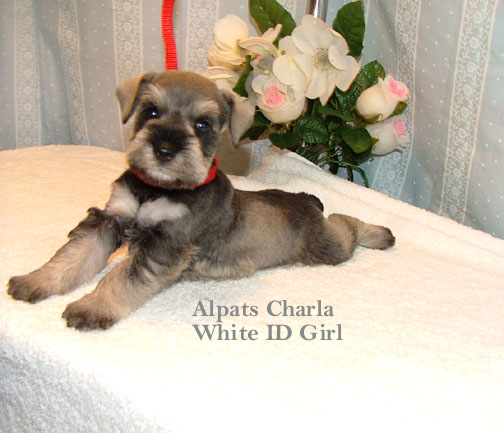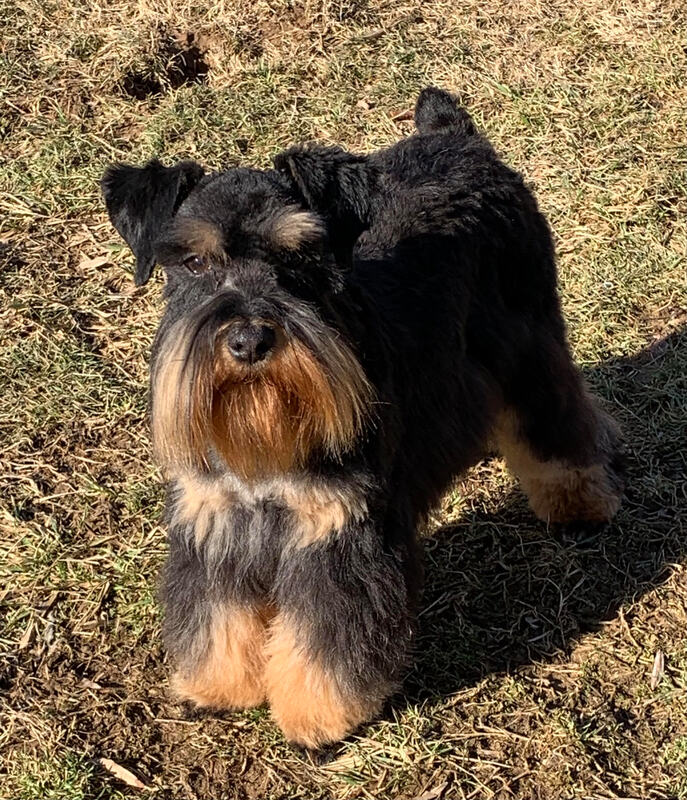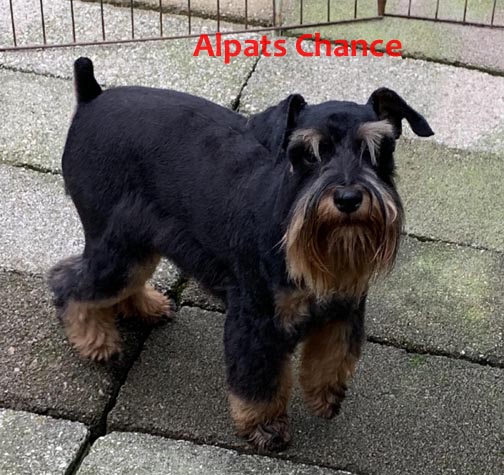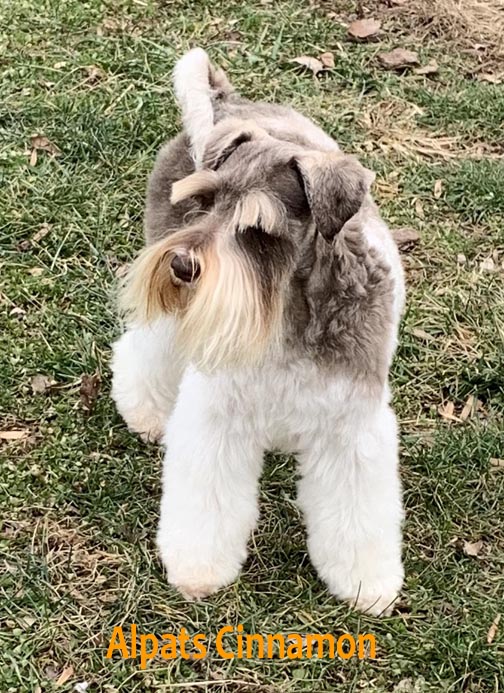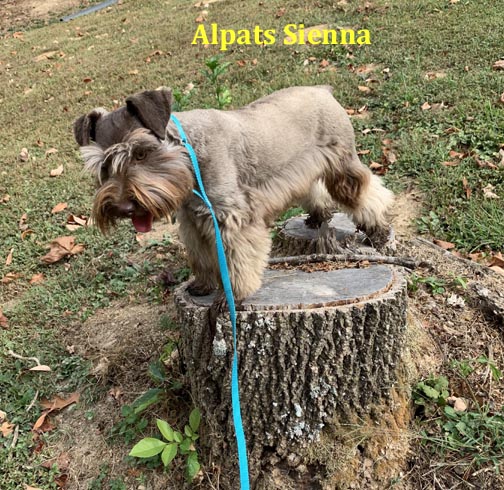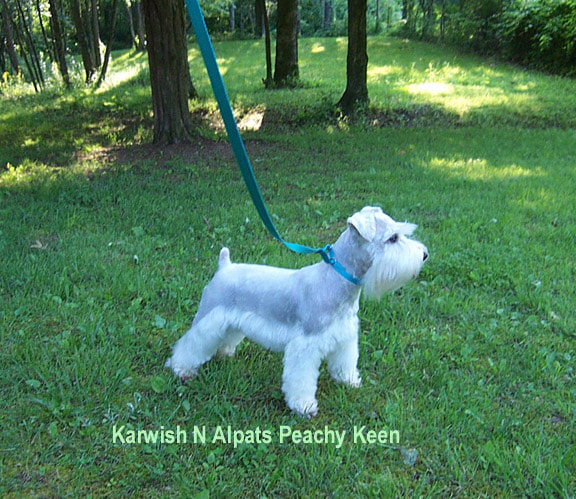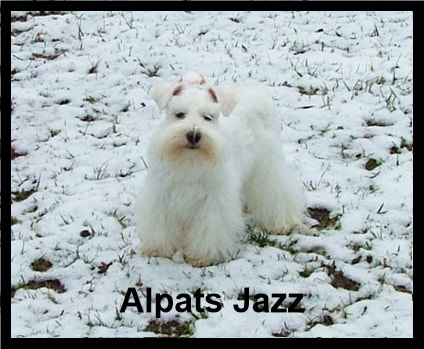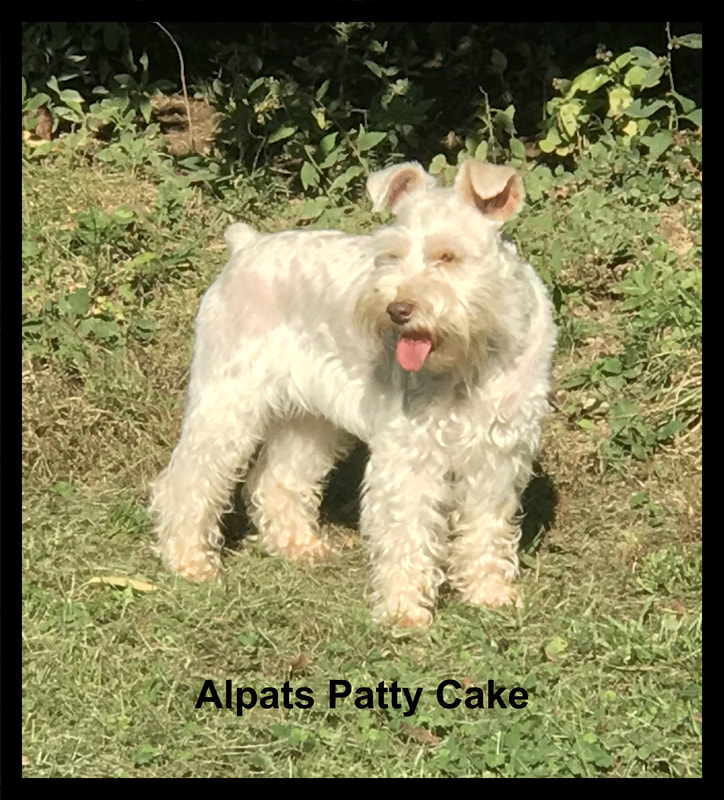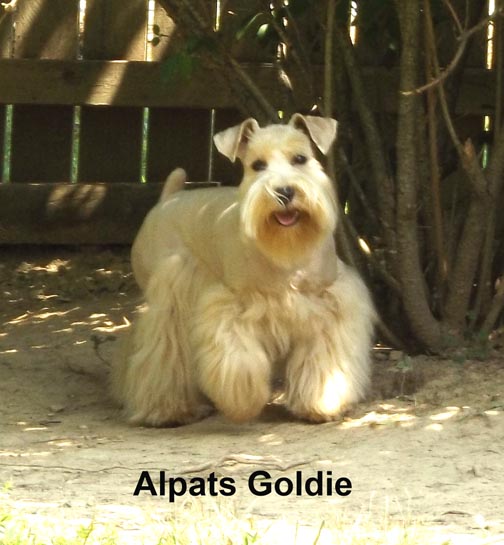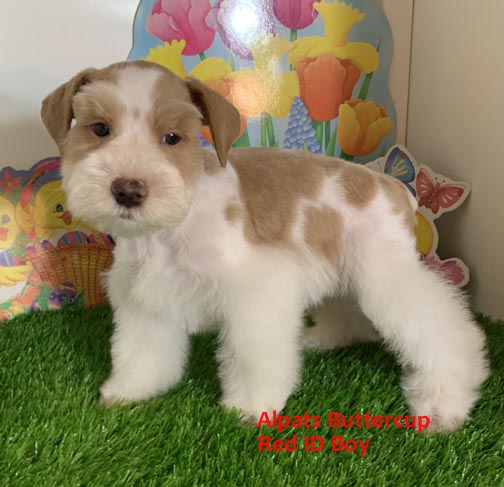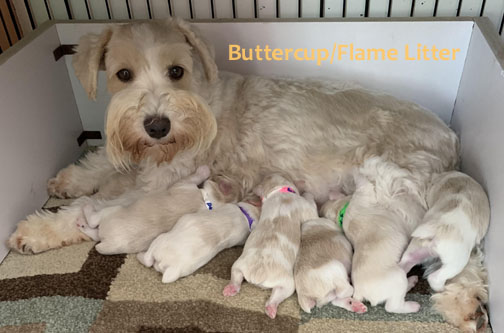Colors And Color History
Alpats Kennel is home to the original colored Miniature Schnauzers as they were found in the beginning of the breed in Germany. Here you will see photos of these nearly lost colors. All are eligible for registration with the AKC but are not allowed to be shown in conformation. These disallowed colors can be shown in Jr. showmanship and all activites such as obedience.
It is my intention to breed these colors into show lines to improve on the conformation and make these colors the same as the 3 allowed colors. I am presently working on this and would encourage any other breeder currently breeding these colors to work on improving them also.
The Abbagamba Kennel in Germany was producing 'Parti' colors in 1929, first appearing from a pair of 'Blacks' and in the U.S. from a pair of 'Salt/Peppers'. 'Red', 'Yellow', and 'Brown' were the prominante colors in the early days of the breed. Many of the first ones imported and bred here in the U.S. were shades of these colors.
I will give a brief description of these colors.
This is not a genetics chart or a lesson.
Alpats Kennel is home to the original colored Miniature Schnauzers as they were found in the beginning of the breed in Germany. Here you will see photos of these nearly lost colors. All are eligible for registration with the AKC but are not allowed to be shown in conformation. These disallowed colors can be shown in Jr. showmanship and all activites such as obedience.
It is my intention to breed these colors into show lines to improve on the conformation and make these colors the same as the 3 allowed colors. I am presently working on this and would encourage any other breeder currently breeding these colors to work on improving them also.
The Abbagamba Kennel in Germany was producing 'Parti' colors in 1929, first appearing from a pair of 'Blacks' and in the U.S. from a pair of 'Salt/Peppers'. 'Red', 'Yellow', and 'Brown' were the prominante colors in the early days of the breed. Many of the first ones imported and bred here in the U.S. were shades of these colors.
I will give a brief description of these colors.
This is not a genetics chart or a lesson.
Typical salt/peppers. Note the banded hair on the adult's jacket. This is a stripped coat so it's never been clipped to destroy the guard coat. The tan on the pup will be silver as an adult.
Black/Silver
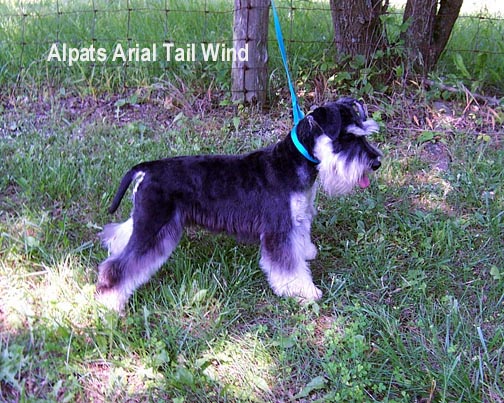
'Black/Silver'
'Black/Silver' is the same as a black doberman, solid black with silver to nearly white markings. The 'Black/Silver' with white markings is NOT a phantom. That is a term some breeders use to extract more money from the buyers pockets. Many times the "Black and Silver" with white markings will fade quicker and become even lighter till it looks like a pale silver color. When looking at a litter of 'Salt/Pepper' and 'Black/Silver' pups check behind the ears for light hair or a brownish color. These are 'Salt/Pepper', not 'Black/Silver', no matter how dark they appear!!!
For those who have one of those RARE "PHANTOM" colored minis. There is NO such color. The gene is a 'Black/Silver'. 'Black/Silver' is 'Black' marked with a dark 'Silver' to nearly pure 'White'. Just like 'Salt/Pepper' the marking vary in shade intensity. This does not make it a new gene.
'Black/Silver' is the same as a black doberman, solid black with silver to nearly white markings. The 'Black/Silver' with white markings is NOT a phantom. That is a term some breeders use to extract more money from the buyers pockets. Many times the "Black and Silver" with white markings will fade quicker and become even lighter till it looks like a pale silver color. When looking at a litter of 'Salt/Pepper' and 'Black/Silver' pups check behind the ears for light hair or a brownish color. These are 'Salt/Pepper', not 'Black/Silver', no matter how dark they appear!!!
For those who have one of those RARE "PHANTOM" colored minis. There is NO such color. The gene is a 'Black/Silver'. 'Black/Silver' is 'Black' marked with a dark 'Silver' to nearly pure 'White'. Just like 'Salt/Pepper' the marking vary in shade intensity. This does not make it a new gene.
Black/Rust also called black/red.
This gene is a variety of black/silver. The markings are a pale tan, black/tan, to a dark rust. This is a recessive gene that works the same as black/silver.
Liver
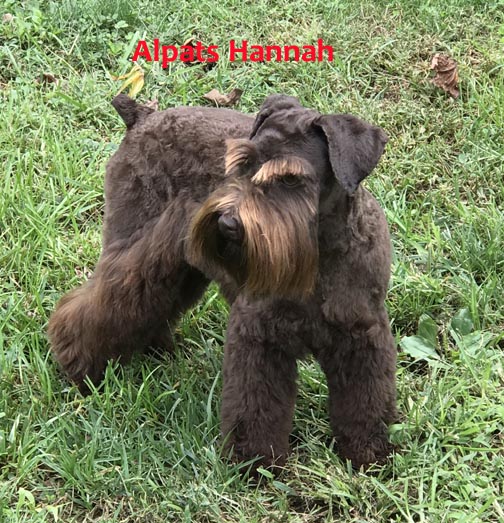
All 'Livers' must have a 'Liver' nose, paw pads, lips and eye rims. NO exceptions unless they are blue! Eyes are usually a greenish Hazel. I have seen some that stay almost Blue. They should be Hazel. 'Liver' is a recessive to 'Black'. MS come in 'Liver', not 'Chocolate' because AKC has made this decision, therefore I will call it 'Liver'.
There are 3 'Liver' colors and 2 different patterns:
1 - 'Liver' - Recessive to 'Black'. This is a solid 'Liver' and can have white markings on the chest and toes just like 'Black'.
Liver/Tan
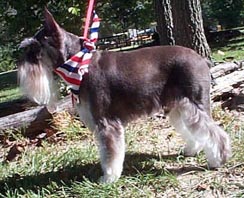
3 - 'Liver/Tan' - Recessive to 'Black/Silver'. Solid 'Liver' body with tan to silver markings exactly like a 'Black/Silver'. This is Trigger who was my mom's pup till she died & then became my brother's dog.
White Chocolate
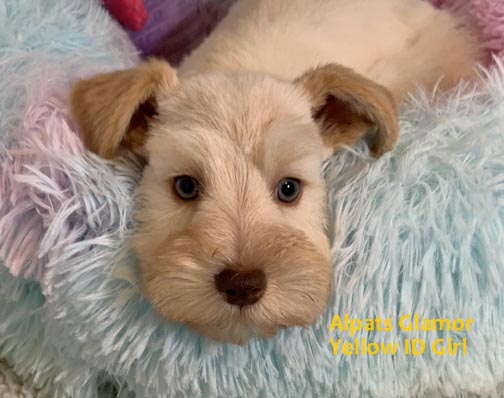
'White'
With 'Liver' nose and points is a recessive to 'White' with 'Black' points. This color is a 'White' "masking" for 'Liver'. I add it here because it's an expression of the 'Liver' gene but actually should be under 'White'.
Note: This dog is cream which is part of the white gene.
With 'Liver' nose and points is a recessive to 'White' with 'Black' points. This color is a 'White' "masking" for 'Liver'. I add it here because it's an expression of the 'Liver' gene but actually should be under 'White'.
Note: This dog is cream which is part of the white gene.
Examples of partis.
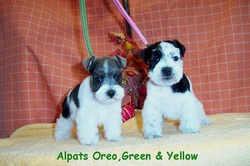
'Parti' is a pattern and can be any color on 'White'. All three AKC accepted colors come in 'Parti' as well as all three 'Liver' colors. The pattern can be spots on a 'White' background or a colored jacket on a 'White' background. head can be any combination. The black/silver gene in any color can be a parti also. The wheaten parti can be any shade from cream to red.
Ticking
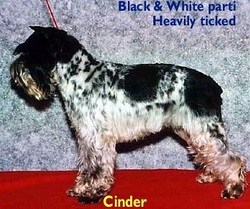
Ticking
Small self colored spots found on 'Parti's' or 'Parti' carriers. Ticking is dominate over non ticking.
Small self colored spots found on 'Parti's' or 'Parti' carriers. Ticking is dominate over non ticking.
Colt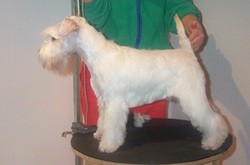 'Colt' Alpats Peace Maker International Champion Swedish Finch Norwegian Estonian Nordic Nordic Winner - 06 2003-2007
Contact: Jane Hagström
[email protected]
Another note about 'White'. It is not a Dapple Gene nor a Harliquin or Dalmation Spotting Gene. 'White' in Miniature Schnauzers is the exact gene as in the 'White' Poodle and does not carry genes for deafness or blindness. White is ee.
Note for those who have what they call a turned 'White'. These are 'Salt/Peppers' expressing an extreme fading gene. They were born 'Salt/Pepper' and will be a genetic 'Salt/Pepper' their entire lives. A genetic 'White' bred to a like White will produce 100% 'White' every time. This turned 'White' color will breed like a 'Salt/Pepper'. |
Jazz seemed to be ice white till he got a few years old & developed a yellowish stripe down his back that only showed if his coat was allowed to grow out.
|
Creams, apricots & reds are all part of the white 'e' series.
Patty Cake on the top left is a cream. Goldie on the top right is an apricot cream. Her coat looked gold in outside lighting. Pup on bottom left is a red parti & the photo on bottom right is a litter of cream to red. Most reds are born a lighter shade & darken. Buttercup is a cream parti but you can't tell it in this photo.
These are shades of the white ee gene.
These are shades of the white ee gene.
